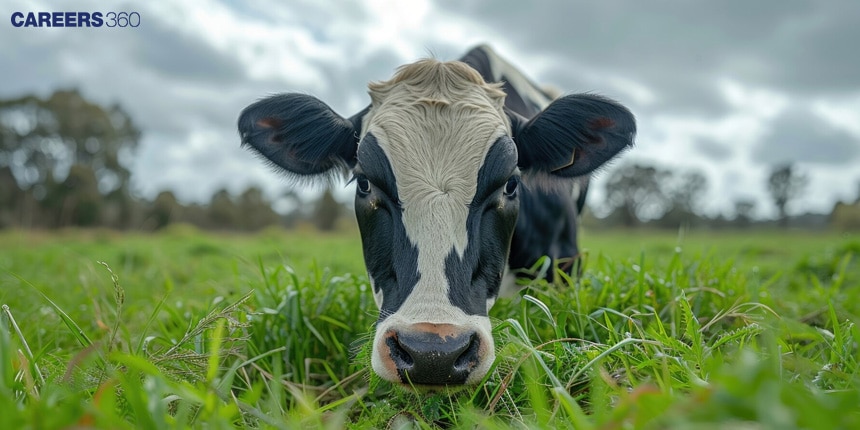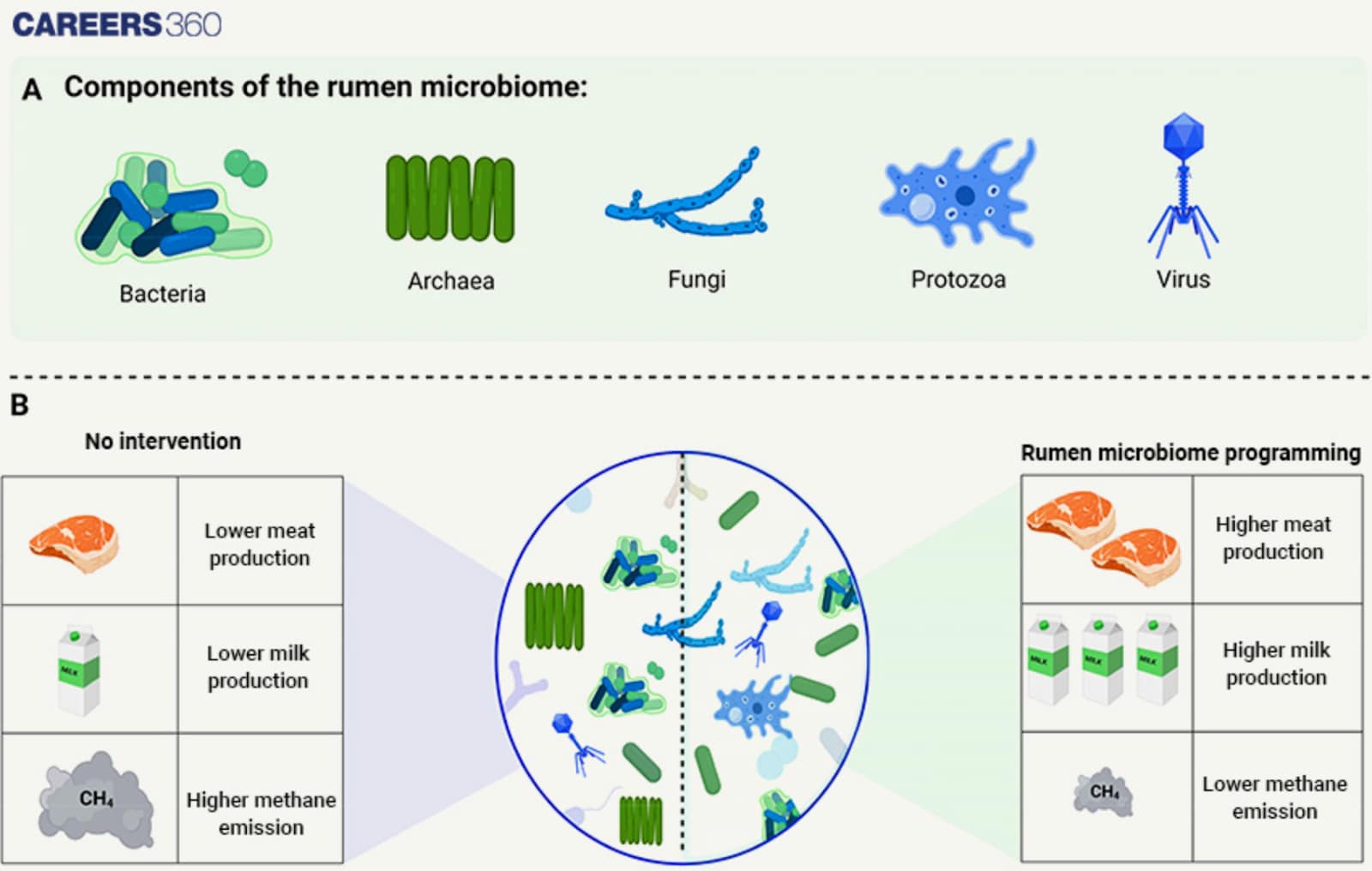Digestion In Ruminants - Structure, Function, Process,Types, Digestion, & Facts
Ruminants include cows, sheep, goats, and deer. These herbivorous animals have a unique digestive system that allows them to digest large amounts of plant material, mainly cellulose. They do not have a single-chambered stomach like that of humans. Ruminants have a four-chambered stomach that enables them to break down plants and absorb nutrients. This topic is included in the Class 11 chapter Digestion and Absorption of Biology.
Don't Miss: Most scoring concepts for NEET | NEET papers with solutions
NEET 2025: Syllabus | PYQs | Crack NEET in 2 months - Study Plan
NEET Important PYQ & Solutions: Physics | Chemistry | Biology | NEET PYQ's (2015-24)
- What are Ruminants?
- Characteristics of Ruminants
- Compartments of the Stomach in Ruminants
- Digestive Process in Ruminants

What are Ruminants?
Ruminants are a particular division of mammals characterized by morphological and physiological differences in their gastrointestinal tract, and they have three-chambered stomaches intended for the digestion of plant tissues. These include animals commonly known as cattle, sheep, goats, and deer. This is important as it shows how such animals can effectively break down plant matter to enable the human body to be provided with vital nutrients through microbial fermentation and the process of regurgitating and chewing the cud.
Characteristics of Ruminants
The characteristics of ruminants are listed below-
Physical Characteristics
Distinctive Anatomical Features: Ruminants have a complex and specialised entire stomach which contains four distinct compartments, including the rumen, reticulum, omasum, and abomasum used in the breakdown of plant matter. They also possess dental pads and do not have upper incisors.
Comparison with Non-Ruminant Herbivores: Horses for example, unlike ruminants, possess a single-chambered stomach and enormous cecum to aid in the process of fermentation.
Behavioural Characteristics
Grazing Habits: There are several subgroups of mammals, some of which include, ruminants, which feed on grasses and other parts of plants, which means they spend most of their time feeding and chewing the cut.
Social Behavior and Herd Dynamics: Many of them are herding animals and that is beneficial when it comes to, protection and the behaviours such as grooming and herding.
Also Read:
- MCQ Practice on Ruminant Digestive System
- Digestion and Absorption
- Human Digestive System
- Absorption of Food
Compartments of the Stomach in Ruminants
The four compartments of the stomach in ruminants are:
Rumen
Structure and Function: The food before entering the rumen is partially or even completely digested, due to the presence of a large sac-like stomach chamber known as the rumen. This serves to hold and process a material which could be plant matter when ingested, mixed with saliva and fermented by microbes.
Microbial Fermentation: It contains numerous bacterial populations, protozoa and fungi, these microorganisms ferment the dietary fibres into simpler molecules, and volatile fatty acids which form the nutritional base for the ruminant.
Diagram of rumen showing microbial environment

Reticulum
Structure and Function: The second chamber is called the reticulum which has a honeycomb-like structure. It collaborates with the rumen to sort large parts from small ones and helps to spit a cud to chew it again.
Role in Regurgitation and Cud Chewing: It acts almost similarly to a sack that is used in rumination in which food is regurgitated before being chewed for a second time to improve its digestion.
Omasum
Structure and Function: The omasum or manyplies has a large number of ridges or leaves for absorption activities due to the large surface area demanded by the organ.
Role in Water and Nutrient Absorption: Regarding the role of the duodenum, it serves to absorb water to thicken the digest, thus decreasing its bulk and at the same time, increasing the nutrient density before the material enters the abomasum.
Abomasum
Structure and Function: The abomasum on the other hand the fourth stomach chamber also known as the true stomach where enzymatic digestion happens. It discharges other juices by which more enzymes are released to continue digesting proteins.
Similarities to a Monogastric Stomach: The Abomasum is the organ in monogastric animals which works like the stomach in that they both are responsible for the digestion of protein and also the preparation of the food for absorption in the intestines.
Digestive Process in Ruminants
The digestive process in ruminants is listed below-
Ingestion and Initial Chewing
Food Intake and Partial Chewing: Those are the ruminant animals and they start the digestion process by grazing to introduce the plant material into the host. The initial chewing is roughly done because its main function is to increase the size of food particles that are to be digested further.
Regurgitation and Re-Chewing (Rumination)
Cud Formation and Re-chewing: The food is swallowed and partially digested in the rumen then the chews and brings it back to the mouth. The ruminant chews again the cud to process it to an even finer state by mixing it together with saliva for digestion.
Benefits of Rumination: This process enhances the effectiveness of breaking down fibrous plant material, boosts the rate of microbial fermentation and thus raises the overall effectiveness of nutrient absorption.
Microbial Fermentation
Breakdown of Cellulose and Fiber: In the rumen bacteria, protozoa and fungi decompose cellulose and fibre into simpler substances in the rumen
Production of Volatile Fatty Acids (VFAs): This fermentation yields short-chain fatty acids, acetate, propionate and butyrate which are then consumed as the main energy source.
Synthesis of Microbial Protein: Microbes also produce proteins which are later used by ruminants for amino acids, that are considered important.
Absorption
Absorption of VFAs in the Rumen: VFAs synthesised in the rumen are absorbed through the wall of the digestive organ with the help of blood vessels to maintain its energy.
Absorption of Water and Nutrients in the Omasum: The omasum serves in the soaking of water and consolidation of nutrients, thus the volume of the digester is to some extent reduced and nutrient uptake is increased.
True Digestion in Abomasum
Secretion of Digestive Enzymes: The abomasum produces hydrochloric acid and enzymes to digest proteins and other constituents.
Breakdown of Proteins and Other Nutrients: As in monogastric animals it has the role of a stomach that is involved with protein digestion and conditioning of the digest for passage through the intestine.
Intestinal Digestion and Absorption
Further Breakdown and Absorption in the Small Intestine: Enzymatic digestion goes on in the small intestine where nutrients are even more digested and assimilated into the bloodstream.
- Role of the Large Intestine: Large intestine osmosis and passive transport of water and electrolytes are the processes through which waste products in the remaining foods are transported to be excreted.
Also Read:
Recommended Video for Digestion in Ruminants
Frequently Asked Questions (FAQs)
Ruminants usually use the processes of ingestion, initial mastication, regurgitation and cud manipulation, microbial fermentation in the dicolyartic rumen, absorption of volatile fatty matter and other nutritional elements and other disintegration in the abomasum-intestinal tract.
Ruminants possess an intuitive two divisions of the stomach; the rumen, reticulum, omasum, and abomasum and they depend on microbial courses to undergo a digestion of the fibrous plant material. It has to be noted that monogastric animals have a single-chambered stomach and, hence, have no extensive fermentation.
- Rumen: Nearly ferments foods by using microbes in the digesting and breaking down of cellulose.
- Reticulum: Aids in the regurgitation of the cud and other breakdown processes.
- Omasum: Has a series of folds that allow it to absorb water and nutrients while it compacts the digest.
- Abomasum: Performs functions similar to a true stomach that has enzymes for carrying out the digestion of proteins.
The cellulolytic microbes in the rumen catabolise cellulose and other complex carbohydrates to VFAs and microbial protein needed in the nutrition and energy of ruminants.
Some fates are bloated, ruminal acidosis, and hardware disease occurrences commonly in cows. Prevention entails feeding the animals well, serving them the right portions, taking them for vet check-ups and washing or sanitising their feeding troughs and bowls.
Also Read
30 Nov'24 03:25 PM
26 Nov'24 05:38 PM
25 Nov'24 06:43 PM
25 Nov'24 05:45 PM
25 Nov'24 04:48 PM
25 Nov'24 03:52 PM
23 Nov'24 04:30 PM
23 Nov'24 10:03 AM